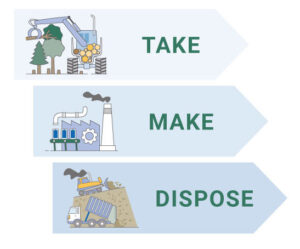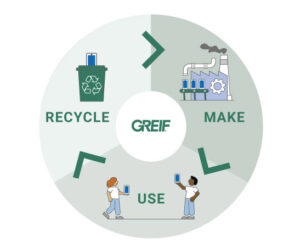LINEAR ECONOMY: TAKE, MAKE, DISPOSE (WASTE)
 Most of the world is based on a linear economy system, in which we take resources from the earth (at a rapid rate), make products from them, and then dispose of them as waste. As such, each product has a clear and marked beginning, middle, and end.
Most of the world is based on a linear economy system, in which we take resources from the earth (at a rapid rate), make products from them, and then dispose of them as waste. As such, each product has a clear and marked beginning, middle, and end.
Because of the linear economy, we are extracting raw materials so fast that they cannot be replenished, and at the same time, the amount of waste we produce continues to grow. Goods are made quickly, used quickly, and then disposed of unsustainably.
Consumerism leads this linear economy model and is characterized by a high volume of new manufacturing, heavy pollution, the degradation of natural systems, and a loss of biodiversity. In short, the linear economy is very bad news for the planet.
So, what are we looking to achieve in an ideal world?
CIRCULAR ECONOMY: MAKE, USE, RECYCLE
 Under a circular economy model, products are made with quality and longevity in mind, used for as long as possible, collected for recycling or reuse if needed, processed, and made again using pre-existing products and by-products.
Under a circular economy model, products are made with quality and longevity in mind, used for as long as possible, collected for recycling or reuse if needed, processed, and made again using pre-existing products and by-products.
Not only does this eliminate waste, but it also provides the additional benefit of adding more sustainable resources to the economy, meaning that fewer ‘virgin’ or ‘new’ natural resources need to be extracted because suitable materials are ready and available for use again.
There are often exponential benefits to be gained from leaving resources in place rather than extracting them, too. For instance, the older and larger a tree grows, the more carbon dioxide it can absorb and the more oxygen it can provide.
PROLONGING PRODUCT USE
Perhaps the most important factor within the circular economy model, is keeping products in use and at their highest value for as long as possible, before they are recycled, re-purposed, or disposed of.
This comes down to two things:
- Building products ‘better’ and more sustainably, with long-lasting usage in mind.
- Consumers using products until they’re no longer working, as opposed to when a new style comes to market.
Recycling, although undeniably essential to a successful circular economy, should be seen as the last resort for a product! Breaking down technical parts for recycling takes energy, and there is much more value in a working car than there is in a piece of metal. This is why it’s important to design and build effectively in the first instance, then re-use, repair, and be inventive when a product begins to wear down.

